Chinatowns
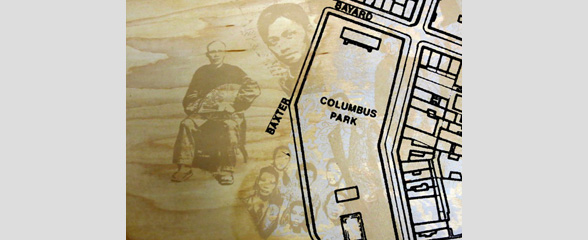
2008.040.001 Oral History Interview with CAAAV Youth February 6, 2008
CAAAV Organizing Asian Communities is a nonprofit community outreach organization dedicated to empowering poor and working class Asian immigrants and refugees in New York City. In this interview, four high school-aged summer interns at CAAAV describe their contributions to a map project that documents the Chinatown landscape. Through excursions in Chinatown, interviews with local residents, and extensive research, these students analyzed the force of gentrifications in New York Lower East Side. Although urban development has made the Lower East Side more safe and attractive, the students express concern for Chinatown long-term and low-income residents who are increasingly priced out of the neighborhood. They go on to consider how the lack of affordable housing and rent-stabilization is threatening Chinatown residents and why it is important to preserve the local community.

2008.040.002 Oral History Interview with Jenny Ye February 2, 2008
Jenny Ye was born in Manhattan in 1991, and has been a resident of Chinatown her whole life. She actively volunteers and coordinates for community-oriented organizations such as Chinatown Youth Initiatives, Committee Against Anti-Asian Violence (CAAAV), Chinatown Literacy Project, and Asian Pacific American Youth Alliance (APAYA). Ye first became aware of gentrification at a Chinatown Tenant Union meeting. She visualizes Chinatown as having aged low-rise buildings, fire escapes, no elevators, and inhabited by mostly immigrant families. When asked to define gentrification, she envisions tall buildings, the process of uprooting low-income communities and shifting them elsewhere to give privilege to more affluent residents who are able to afford the renovated real estate. Ye argues that gentrification does not solve issues with safety, crime, sanitation, and poverty because it merely relocates it to another neighborhood. However, she also empathizes with landlords because her parents, who have investments in real estate, rely on gentrification and the ability to raise rent in order to sustain the family’s quality of life. Finally, Ye talks about the changes in Chinatown, claiming that it is now shrinking, and explains that the changes occurred without consideration for the neighborhood’s businesses and residents; in other words, she fears that gentrification will transform Chinatown into “South SoHoâ€.

2008.040.003 Oral History Interview with Ching Yeh Chen February 6, 2008
Born in Chongqing, China and raised in Taiwan, Ching Yeh Chen came to the United States in 1971 to pursue a graduate and masters degree. Chen finally settled in New York and joined her husband operating a retail corporation, Pearl River Market, which was officially founded in 1980. Discussing the history of Pearl River, Chen explains that the corporation had been created to introduce the “real China†to the American society, since as Chen argues there was no significant relationship between the two countries at that time. Some of the challenges the company confronted included government suspicions, increasing rent prices, and an ever-changing customer base. Chen describes Chinatown as being a relatively unsafe environment during the seventies and eighties, which she believes began to change in 1990. She also describes both the rise of the American tourist clientele during the 1990s and the shrinking Chinese garment factory customer base. Finally, she predicts that after a decade, when their lease expires, Pearl River may fade away, as she and her husband will be reaching retirement age and the business will not be handed down to their children. Nonetheless, from her perspective, change is invaluable and Chinatown businesses and residents must be open to the neighborhood evolving – “that’s the challenge, that’s the pressure, that’s the fun.â€
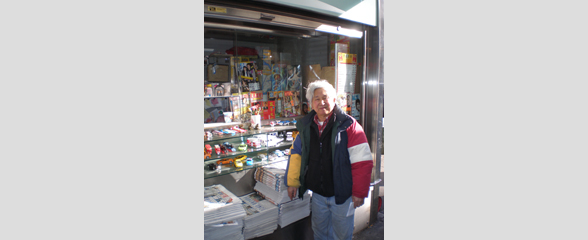
2008.040.004 Oral History Interview with Francis Tso July 13, 2010
Francis Tso moved to the United States from Hong Kong in 1976, and settled two year later in Chinatown. For over thirty years, he and his wife have run a newsstand located on Canal Street that was handed down from Tso’s father and leased through the city. Tso portrays Chinatown as a haven for those who do not speak English and, while he says he has seen an increase in business at his stand as a result of development in the area, he also realizes that many non-English speakers are finding it increasingly difficult to stay in Chinatown. They are in an especially hard situation, he says, because their lack of English knowledge prohibits them from moving elsewhere. Over the thirty years that Tso has lived and worked in Chinatown, he has seen many buildings and business dissolved or torn down. As his stand is on Canal Street, he has also witnessed firsthand the increase in the counterfeit market on Canal. Again, Tso sees two sides to the issue. While more customers at the counterfeit stands means more potential customers at his newsstand, he would like to see a community center built in Chinatown that could offer a place for young people to “hang outâ€â€”keeping them away from the counterfeit market. When asked if he might consider retiring, Tso firmly answers that he will continue to operate the stand as long as he is physically able, even though none of his children are interested in running the stand themselves.
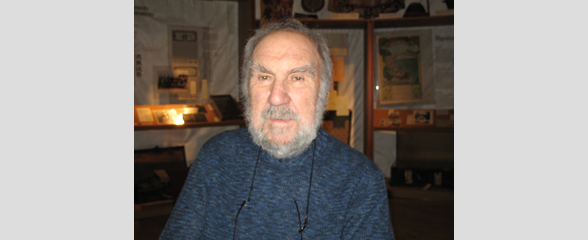
2008.040.006 Oral History Interview with Bert Feinberg December, 21, 2008
Bert Feinberg, native to Brooklyn and long-term resident of New York, describes his experiences in Chinatown and the block often referred to as the Daily Forward block, colloquially named after the Yiddish Daily Forward newspaper. There, Feinberg was employed at a family-owned catering and restaurant business called the Garden Cafeteria. During his time at the Cafeteria between 1949 and 1974, he saw significant demographic changes in the neighborhood. Feinberg initially estimates that the Daily Forward block was ninety percent Jewish residents and businesses. By the sixties, and more so the seventies, he observed significant geographic and demographic expansion in Chinatown due to the influx of Chinese immigrants establishing residency and businesses there. Feinberg recalls the unique mixture of customers who frequented the Cafeteria, such as clientele from the Workmens Circle and the Daily Forward, who created a close-knit community within the restaurant. However, as housing became more expensive and long-established businesses relocated or sold their property, the Jewish community gradually dissipated and disappeared. Feinberg ponders whether Chinatown will experience similar changes as the once predominantly inhabited Jewish community, as he has noticed that with increasing gentrification and higher education, younger Chinese generations are choosing professional careers over sustaining family businesses.
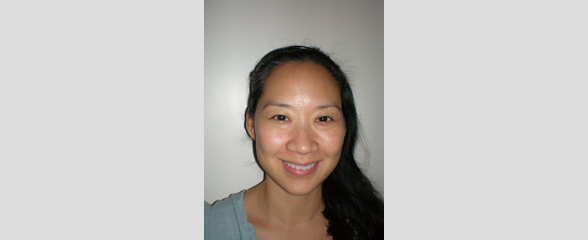
2008.040.008 Oral History Interview with Betty Sze October 25, 2007
Betty Sze discusses her vague memory of spending her early childhood playing outside of the Grand Machinery Exchange building, which was located on Centre Street. Her father owned a produce wholesale supply company, while her mother worked in factories. In her interview, she describes gentrification in terms of rent-prices consistently rising, developers becoming more aggressive in planning building projects, and entire neighborhoods such as Little Italy, being taken over by Chinese residents and businesses. Sze characterizes present-day Chinatown as a place that is more attractive to “Westerners†and inviting to tourists. She views tourism as having a positive economic effect on Chinatown, as well as contributing to the vibrancy of the neighborhood, but she also acknowledges that tourism has driven prices up and perhaps detracted from the authenticity of the Chinatown experience. While she has seen many of the special landmarks from her youth disappear from Chinatown, she still considers the neighborhood her spiritual home and an authentic Chinese American experience.
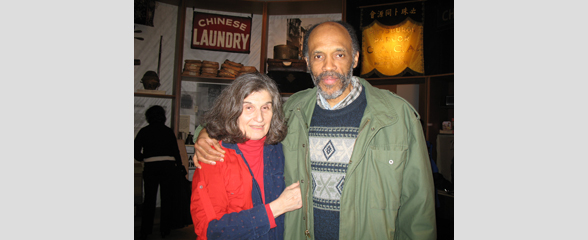
2008.040.009 Oral History Interview with Daniel Carter and Marilyn Sontag January 2, 2008
Husband and wife Daniel Carter and Marilyn Sontag moved together to Chinatown in 1970, where they continue to live and work today—Carter as a musician and writer and Sontag as an abstract artist and part-time gallery coordinator. In their interview, they describe their meeting in Italy and their decision to subsequently relocate to New York City. The couple illustrates Chinatowns community of artists present during the 70s and 80s, and describes the ways in which that atmosphere has changed. Additionally, they explain how they have seen an evolution in SoHo and Little Italy, evident in the increased development and prevalent “boutique culture.†Along these same lines, Carter and Sontag also see a gradual but seemingly constant change in population: as younger, wealthier residents move in, older residents—particularly Asian and Italian residents—are pushed out by higher rent prices. Both would like to see more affordable housing in Chinatown, Little Italy, and SoHo, and Carter expresses a personal struggle with what he perceives as disregard or disrespect for customs and culture in New York, or what he refers to as “brutal displacement.â€
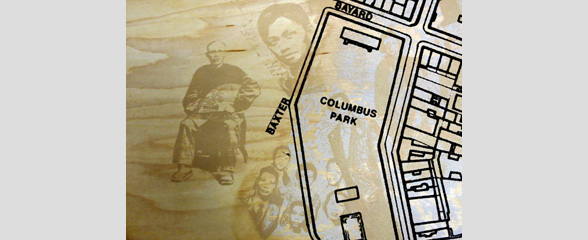
2008.040.011 Oral History Interview with Howard Pyle January, 15 2008
Howard Pyle talks to MOCA about his experiences moving into the broader Chinatown area during the booming dot-com years of the 1990s and how he has witnessed things change since then. He offers listeners some interesting context for the rise and fall of the dot-com bubble and how 9/11 affected many parts of lower Manhattan and led to shifts in population. Howard also goes into detail about the punk scene in DC where he was from and how he felt when he first moved to NYC and was forced to learn the cultural geography. He shares his experience with the Yellow Arrow Project as well as his thoughts on what connects people to the spaces they visit or inhabit. The conversation concludes with Howards thoughts on the term gentrification and the real-world impacts of gentrification on NYC and the artists who live there.

2008.040.015 Oral History Interview with Kam Mak March 6, 2008
Kam Mak is an artist who emigrated with his parents from Hong Kong to the United States at age ten in 1971. In this interview, he vividly describes growing up in an old tenement building on Eldridge Street and becoming involved with street kids during the seventies. He mentions the strong presence of street gangs during his childhood as well as the turning point during his youth that redirected him towards art as an escape from getting into trouble. Mak also discusses conceptual ideas that inspire his artwork, which is heavily influenced by his sensory impressions of the Chinatown neighborhood and culture. He notes the changes in neighborhood dynamic since then, observing differences in population, safety, and lifestyle. After moving out of Chinatown in the early 90s, Maks art became a means to reconnect or save his ties to the Chinatown community. He goes on to describe his work writing and illustrating his childrens book My Chinatown and designing a series of Lunar New Year stamps for the U.S. Postal Service. Reflecting on how Chinatown’s identity is rooted in its low-income and immigrant residents, he laments about how the forces of gentrification could eventually erode Chinatown to a “fake†shell of its former glory.
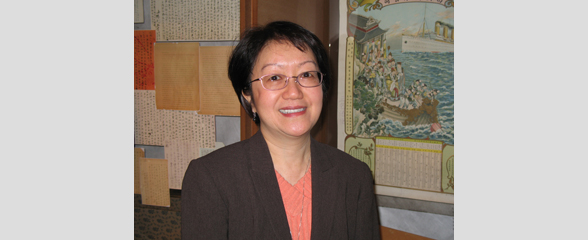
2008.040.017 Oral History Interview with Margaret Chin March 6, 2008
Margaret Chin, Deputy Executive Director of Asian Americans for Equality (AAFE), shares her experiences immigrating to the United States with her family in 1963 and growing up on Mulberry Street, and later Mott Street, both of which were inhabited by predominantly Chinese and Italian populations. Her memories of Chinatown reveal that it was a much smaller community then, which eventually expanded and became more vocal about Asian American rights.
As a young adult, Chin became increasingly interested in and involved with volunteering for AAFE, an advocacy organization established in 1974. AAFE played a key role in organizing Chinatown tenants to fight against eviction, harassment, and gentrification in the housing developments; to secure decent housing for low-income families; and to expose the threat of development and tourism on Chinatowns “authenticityâ€. Chin believes that the organization has succeeded in staying true to its mission by actively organizing and changing policy and legislation for the benefit of the community.